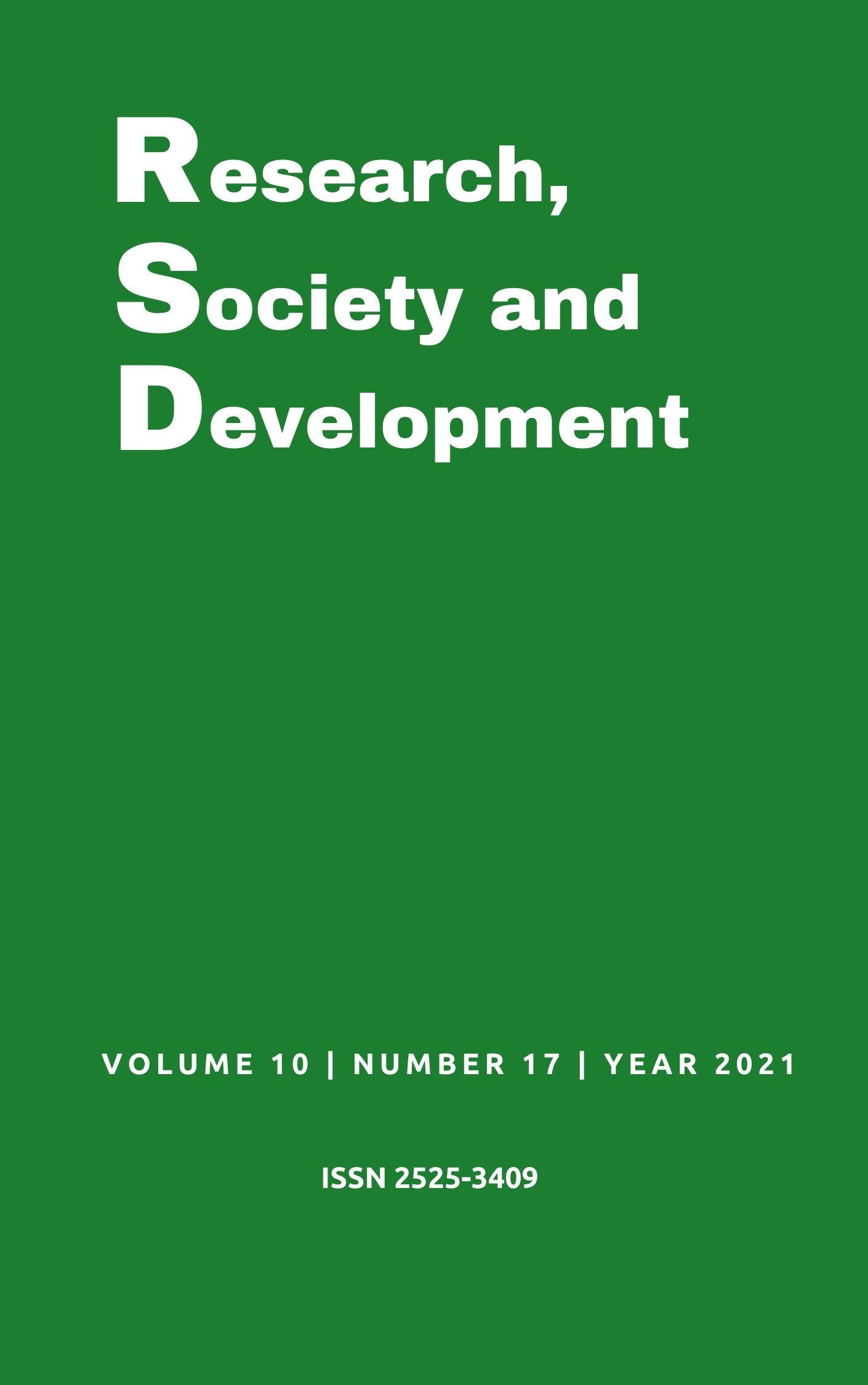Caracterización del régimen fluvial de la cuenca hidrográfica del río Acre
DOI:
https://doi.org/10.33448/rsd-v10i17.24461Palabras clave:
Régimen fluvial, Río Acre, Disponibilidad hídrica.Resumen
El régimen fluvial de un río representa la variación del volumen de agua durante un período y es una herramienta fundamental para el estudio de la disponibilidad hídrica. En esa dirección, este estudio tuvo como objetivo caracterizar el régimen hídrico fluvial de la cuenca hidrográfica del río Acre, teniendo en cuenta la dinámica espaciotemporal para estudiar su disponibilidad hídrica. Se identificaron caudales promedios, máximos y mínimos, anuales y mensuales, obtenidos mediante el tratamiento estadístico de datos fluviales de cinco estaciones a lo largo del río Acre, puestos a disposición por ANA (Agência Nacional de Água e Saneamento Básico). Se verificó que el período de mayor disponibilidad hídrica, para las series históricas estudiadas, ocurrió entre los meses de diciembre y abril, mientras que el período con menor caudales mensuales promedio ocurrió entre junio y septiembre.
Referencias
Accorsi O. J., Lima E. F. P., Alcoforado L. F., & Longo O. C. (2017). Estudo do comportamento da cota mínima do rio Acre nos últimos 43 anos e as consequências para o assoreamento futuro do rio. Geociências, 36(2), 315-324.
ACRE. Secretaria de Estado de Meio Ambiente (2012). Plano estadual de recursos hídricos do Acre. Rio Branco: SEMA.
ACRE. Secretaria de Estado de Planejamento (2017). Acre em números. SEPLAN.
ANA - Agência Nacional de Águas e Saneamento Básico (2021). Política Nacional de Recursos Hídricos. Recuperado em 2 de setembro, 2021, de https://www.gov.br/ana/pt-br/assuntos/gestao-das-aguas/politica-nacional-de-recursos-hidricos
Buffon, F. T. & Bonotto G. (2018). Ferramentas de apoio na operação do sistema de alerta da bacia do rio acre do serviço geológico do Brasil – SGB/CPRM. I Encontro Nacional de Desastres.
Capozzoli C. R., Cardoso A. O., & Ferraz S. E. T. (2017). Padrões de Variabilidade de Vazão de Rios nas Principais Bacias Brasileiras e Associação com Índices Climáticos. Revista Brasileira de Meteorologia, 32(2), 243-254.
CEMADEM – Centro Nacional de Monitoramento e Alertas de Desastres Naturais (2016). Panorama hídrico no estado do Acre: diagnóstico, perspectivas e impactos potenciais relacionados à situação de seca. Recuperado em 5 de outubro, 2021, de http://www2.cemaden.gov.br/wp-content/uploads/2016/08/NT.Cemaden.SecaAcre.10082016.pdf.
CPMR – Serviço Geológico do Brasil. (2021). Bacia do Rio Acre-Características. https://www.cprm.gov.br/sace/acre_caracteristicas.php
Duarte, A. F. (2011). As chuvas e as vazões na bacia hidrográfica do rio Acre, Amazônia Ocidental: Caracterização e implicações socioeconômicas e ambientais. Amazônia: Ciência & Desenvolvimento, 6(12), 161-183.
Duarte, A. F. (2009). Hidrometria no Acre: fluviometria e hidroquímica. Rio Branco: EDUFAC.
Duarte, A. F. (2005). Variabilidade e tendência das chuvas em Rio Branco, Acre, Brasil. Revista Brasileira de Meteorologia, 20(1), 37-42.
Heller, L. & Padua, V. L. (2010). Abastecimento de Água para Consumo Humano. Belo Horizonte: Editora UFMG.
INMET - Instituto Nacional de Meteorologia. (2017). Situação da seca observada nas regiões norte e nordeste do brasil em 2016. Recuperado em 12 de novembro, 2021, de https://portal.inmet.gov.br/uploads/notastecnicas/trabalho_tecnico_02-2017.pdf.
Lima, J. E. F. W., Montenegro, S., De Assunção Montenegro, A. A., & Koide, S. (2015). Comparative hydrology: relationships among physical characteristics, hydrological behavior, and results of the SWAT model in different regions of Brazil. Revista Brasileira de Geografia Física, 7(6), 1187-1195.
Macêdo, M. N. C., Dias, H. C. T., Coelho, F. M. G., Araújo, E. A., Souza, M. L. H., & Silva, E. (2013). Precipitação pluviométrica e vazão da bacia hidrográfica do Riozinho do Rôla, Amazônia Ocidental. Ambiente & Água, 8(1), 206-221.
Moreira, J. G. V. & Naghettini, M. (2016). Detecção de tendências monotônicas temporais e relação como os erros dos tipos I e II: Estudo de caso em series de precipitações máximas anuais no estado do Acre. Revista Brasileira de Meteorologia, 31(4), 394-402.
Rocha, P. C. & Dos Santos, A. A. (2018). Hydrological analysis in water basins. Mercator, 17, 1-18.
R CORE TEAM. (2020). R: A language and environmental for statistical computing. R Foundation for Statistical Computing, Vienna, Austria.
Sena, J., Beser De Deus, L., Freitas, M., & Costa, L. (2012). Extreme events of droughts and floods in Amazonia: 2005 and 2009. Water Resources Management, 26(6), 1665-1676.
Shiklomanov, I.A. (1998). World water resource: a new appraisal and assessment for the 21st century. UNESCO.
Silva J. R. S., Mesquita, A. A., Serrano R. O. P., & Moreira J. G. V. (2020). Produtividade de mandioca na mesorregião Vale do Juruá, Acre, Brasil. Enciclopédia Biosfera, 17(33), 381-391.
Simon, F. W., Pickbrenner K., & Marcuzzo F. F. N. (2013). Estudo do regime hídrico pluvial e fluvial em bacia hidrográfica com precipitação homogênea. XX Simpósio Brasileiro de Recursos Hídricos.
Sousa J. W. (2020). Características climáticas do município de Rio Branco, Acre, período de 1990-2019. Scientia Naturalis, 2(2), 723-740.
Tucci, C. E. M. (2012). Hidrologia: ciência e aplicação, Editora UFRGS.
Tucci, C. E. M. (2002). Regionalização de vazões. Editora UFRGS.
Descargas
Publicado
Número
Sección
Licencia
Derechos de autor 2021 Daniela Silva Tamwing; Carolina de Lima Accorsi Montefusco; Rodrigo Otávio Peréa Serrano; Anderson Azevedo Mesquita; José Genivaldo do Vale Moreira

Esta obra está bajo una licencia internacional Creative Commons Atribución 4.0.
Los autores que publican en esta revista concuerdan con los siguientes términos:
1) Los autores mantienen los derechos de autor y conceden a la revista el derecho de primera publicación, con el trabajo simultáneamente licenciado bajo la Licencia Creative Commons Attribution que permite el compartir el trabajo con reconocimiento de la autoría y publicación inicial en esta revista.
2) Los autores tienen autorización para asumir contratos adicionales por separado, para distribución no exclusiva de la versión del trabajo publicada en esta revista (por ejemplo, publicar en repositorio institucional o como capítulo de libro), con reconocimiento de autoría y publicación inicial en esta revista.
3) Los autores tienen permiso y son estimulados a publicar y distribuir su trabajo en línea (por ejemplo, en repositorios institucionales o en su página personal) a cualquier punto antes o durante el proceso editorial, ya que esto puede generar cambios productivos, así como aumentar el impacto y la cita del trabajo publicado.


